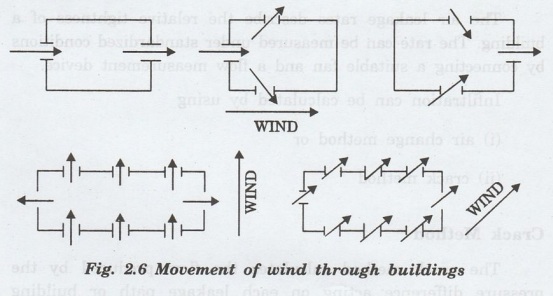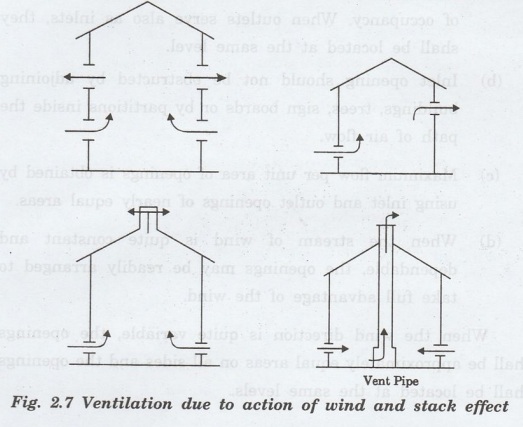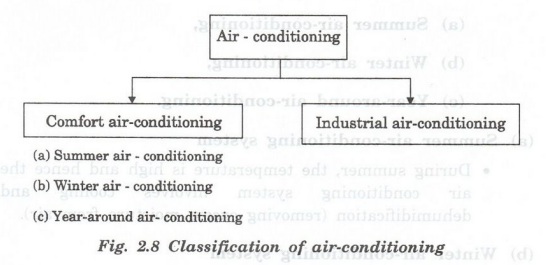Physics For Civil Engineering: Unit II: Ventilation And Refrigeration
Design For Natural Ventilation, Air-conditioning
Definition, Working Principle, Classification
(a) Inlet openings in the building should be well distributed and should be located on the windward side at a low hotel level. The outlet openings should be located on the leeward (direction of downwind) side near the top.
DESIGN FOR NATURAL VENTILATION
1. By wind action
(a) Inlet openings in the building
should be well distributed and should be located on the windward side at a low
hotel level. The outlet openings should be located on the leeward (direction of
downwind) side near the top. Hence, incoming air stream is passed over the
occupants. go the i (Fig. 2.6)

Inlet and outlet openings at high levels
may only clear the top air without producing air movement at the level of
occupancy. When outlets serve also as inlets, they shall be located at the same
level.
(b) Inlet opening should not be
obstructed by adjoining buildings, trees, sign boards or by partitions inside
the path of air flow.
(c) Maximum flow per unit area of
openings is obtained by using inlet and outlet openings of nearly equal areas.
(d) When the stream of wind is quite
constant and dependable, the openings may be readily arranged to take full
advantage of the wind.
When the wind direction is quite
variable, the openings shall be approximately equal areas on all sides and the
openings shall be located at the same levels.
Thus, no matter what the wind direction
is, there are always some openings directly exposed to wind pressure.
2. By stack effect
Natural ventilation by stack effect
occurs when air inside a building is at
a different temperature than air outside. The outside air will tend to enter
through openings at low level. The warm air will tend to leave through openings
at high level.
Thus, ventilators should be provided as
close to ceilings as possible.
Ventilators can also be provided in
roofs.
For example, cowl, vent pipe, covered
roof and ridge vent. (Fig. 2.7)

Air-conditioning
Air –conditioning means not only the control of temperature but
also of humidity, oxygen content, purity and air movement.
In addition, filtering and cleaning of
air is also carried out by the air-conditioning systems.
• Air-conditioning is
required for human comfort.
Definition
It
is defined as the process of controlling and maintaining the properties of air
like temperature, humidity, purity, direction of flow etc., in a closed space.
Principle
of Air-conditioning
The air-conditioner continuously draws
an air from indoor space and cools it by the refrigeration principle and
discharges it back into the same indoor space.
Classification
of Air-conditioning systems
The air-conditioning systems are
classified into two main categories as,
(i) Comfort air-conditioning
(ii) Industrial air-conditioning
Comfort air-conditioning system
• It is to provide the environment with
the required temperature and humidity for human comfort, health and efficiency.
• Comfort air-conditioning system is
used in offices, houses, shops, hospitals, libraries, hotels, theatres etc.
• The comfort air-conditioning is
further classified into:
(a)
Summer air-conditioning,
(b)
Winter air-conditioning,
(c)
Year-around air-conditioning.
(a) Summer
air-conditioning system
• During summer, the temperature is high
and hence the air conditioning system involves
cooling and dehumidification (removing excess moisture from air).
(b) Winter air-conditioning system
• During winter, atmospheric temperature
is quite low ow and hence air conditioning involves heating and humidification
to elove (adding moisture of air) to provide comfort.
(c) Year-around air-conditioning system
• Year-around air conditioning system
has both summer staiwand winter air-conditioning systems.
• There are so many combinations of
arrangement used. One part of the system works in summer and other in winter.
Industrial air-conditioning system
The aim of this system is to provide the
environment with the required temperature and humidity, according to the
applications.
Classification
of air-conditioning based on the equipment arrangement
Based on the equipment arrangement, the
air-conditioning can also be classified as unitary and central type.
(i)
Unitary air-conditioning: The unitary or window type
air-conditioner is of small capacity (of 1/2 to 2 tonnes), used for
air-conditioning of rooms, small offices.
(ii)
Cental air-conditioning: The central air--conditioning is
of large capacity (around 50 to 100 tonnes), used for air-conditioning of large
commercial buildings.

General
principle of Air-conditioning
All the above systems invariably adopt
the same cycle of operations as given below.
• Sucking the air through
the filter media.
• Cooling the air in
summer and heating it in winter.
• Dehumidifying
if it is to be cooled or humidifying if it is to be heated.
• For using the processed air into the rooms space for proper circulation through grills
• Collecting the used air through exhaust and mixing Juo nie with the outside air and sucking again the air through
Physics For Civil Engineering: Unit II: Ventilation And Refrigeration : Tag: : Definition, Working Principle, Classification - Design For Natural Ventilation, Air-conditioning
Related Topics
Related Subjects
Physics for Civil Engineering
PH3201 2021 Regulation | 2nd Semester Civil Dept 2021 Regulation
